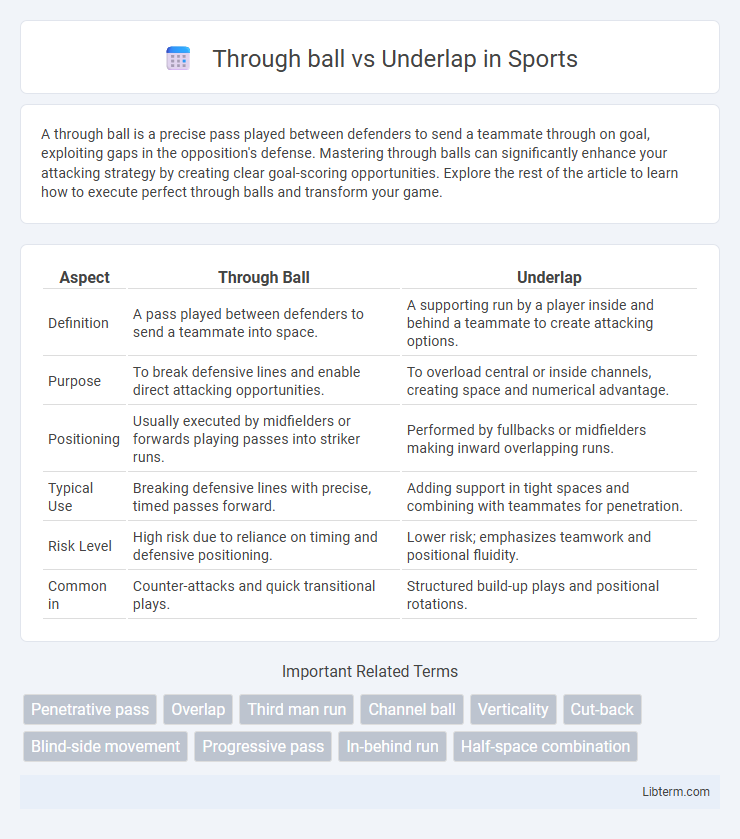A through ball is a precise pass played between defenders to send a teammate through on goal, exploiting gaps in the opposition's defense. Mastering through balls can significantly enhance your attacking strategy by creating clear goal-scoring opportunities. Explore the rest of the article to learn how to execute perfect through balls and transform your game.
Table of Comparison
| Aspect | Through Ball | Underlap |
|---|---|---|
| Definition | A pass played between defenders to send a teammate into space. | A supporting run by a player inside and behind a teammate to create attacking options. |
| Purpose | To break defensive lines and enable direct attacking opportunities. | To overload central or inside channels, creating space and numerical advantage. |
| Positioning | Usually executed by midfielders or forwards playing passes into striker runs. | Performed by fullbacks or midfielders making inward overlapping runs. |
| Typical Use | Breaking defensive lines with precise, timed passes forward. | Adding support in tight spaces and combining with teammates for penetration. |
| Risk Level | High risk due to reliance on timing and defensive positioning. | Lower risk; emphasizes teamwork and positional fluidity. |
| Common in | Counter-attacks and quick transitional plays. | Structured build-up plays and positional rotations. |
Introduction to Through Ball and Underlap
A through ball is a precise pass played into space behind the defensive line, enabling attackers to run onto the ball and create scoring opportunities. An underlap occurs when a player runs on the inside channel, between the opponent's fullback and center-back, often drawing defenders out of position to create attacking angles. Understanding the tactical nuances of through balls and underlaps is essential for unlocking defenses and enhancing team offensive dynamics.
Defining the Through Ball in Football
The through ball in football is a precise pass played between or behind defenders to set a teammate on a direct run toward goal, exploiting defensive gaps. This technique relies on timing, accuracy, and vision to break defensive lines, often leading to high-quality scoring opportunities. Unlike underlaps, where players overlap inside the wide areas to create space, through balls focus on penetrating central defensive zones with incisive passes.
Understanding the Underlap Technique
The underlap technique in football involves a player making a diagonal run between the wide player and the full-back to create space and options for a pass, often exploiting defensive gaps effectively. This approach contrasts with the through ball, which focuses on threading a direct pass into a forward-running teammate behind the defense. Mastering underlap runs requires precise timing, spatial awareness, and coordination to disrupt defensive structures and open attacking lanes.
Tactical Differences: Through Ball vs Underlap
Through balls are precise passes played behind the defensive line to exploit space for attackers making forward runs, emphasizing direct vertical penetration. Underlaps involve a supporting player running inside the wide teammate to create numerical superiority in tight spaces, prioritizing lateral movement and positional interchange. These tactical differences highlight through balls as vertical, line-breaking plays, while underlaps focus on synchronized inward runs to destabilize defensive structures.
Key Situations for Using a Through Ball
Using a through ball is most effective in counter-attacking scenarios where attackers exploit defensive gaps behind the opposition's backline. Precision timing and space between defenders are critical for a successful through ball, allowing forwards to run onto the ball at pace and create clear goal-scoring opportunities. This tactic is especially valuable in quick transitions and against high defensive lines, enabling strikers to face goal with minimal pressure.
Effective Scenarios for the Underlap
Effective scenarios for the underlap typically arise when wide defenders or wing-backs cut inside to create numerical superiority in congested midfield areas. This movement exploits space between opposition full-backs and center-backs, allowing supporting midfielders or forwards to make penetrating runs into the vacated wide channels. Underlaps are particularly effective against teams that press high or maintain narrow defensive shapes, providing alternative passing lanes and destabilizing defensive structures.
Advantages and Disadvantages of Each Approach
Through balls create direct attacking opportunities by swiftly bypassing defensive lines, enabling forwards to exploit open spaces behind defenders; however, they rely heavily on precise timing and accurate passing to avoid offsides and interceptions. Underlaps involve overlapping runs on the inside channels, offering numerical superiority and cleaner passing angles in tight areas, yet they can sometimes congest midfield spaces and require strong coordination to prevent defensive vulnerability. Choosing between through balls and underlaps depends on team strategy, player positioning, and opponent defensive structure.
Player Roles and Positioning
Through balls exploit gaps between defenders by targeting forwards or attacking midfielders positioned behind the defensive line, requiring precise timing and vision from playmakers. Underlaps involve full-backs or wing-backs making diagonal runs inside the wide areas to create overloads, demanding strong coordination with midfielders to exploit central channels. These distinct roles and positioning strategies emphasize attacking flexibility and spatial manipulation to break down defensive formations.
Examples from Professional Matches
Through balls create direct passing lanes that bypass defenders, as seen in Lionel Messi's precision assists at FC Barcelona, enabling forwards like Luis Suarez to exploit defensive gaps. Underlaps involve midfielders or wingers cutting inside behind the full-backs, exemplified by Kevin De Bruyne's dynamic runs at Manchester City that overload central areas and create shooting opportunities. Both tactics disrupt defensive structures but through balls emphasize timing and vision, while underlaps rely on spatial awareness and coordinated movement.
Choosing the Right Option: Tactical Decision-Making
Choosing between a through ball and an underlap depends on spatial awareness and player positioning to exploit defensive weaknesses effectively. A through ball targets teammates making forward runs in behind the defensive line, capitalizing on pace and timing, while an underlap involves overlapping runs that cut inside, creating overloads near the penalty area. Tactical decision-making hinges on defenders' alignment and midfield support, optimizing attacking options to maintain possession and increase scoring opportunities.
Through ball Infographic

 libterm.com
libterm.com